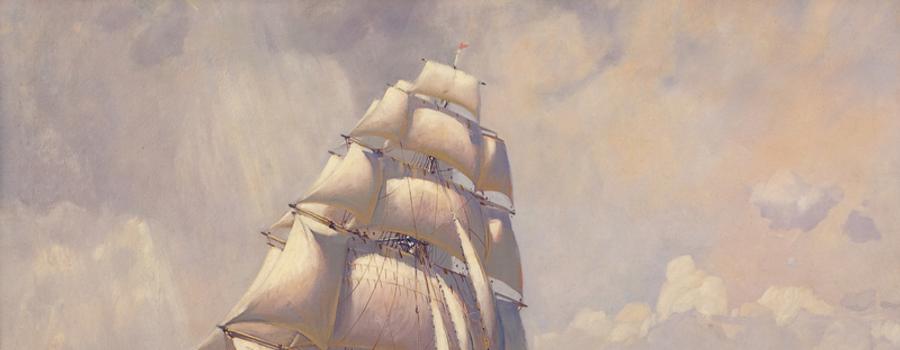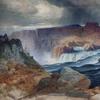Frank Vining Smith: Maritime Painting in the 20th Century
- July 13, 2010 16:54

The marine art of Frank Vining Smith (1879-1967) has become part of America's collective consciousness. When we envision a wind-propelled sailing ship plying the high seas, often the image in our mind's eye is inspired by, if not actually painted by, Smith. Prints of his ship paintings adorn seafood restaurant walls, original oils grace art museums and corporate office suites, and his best works now inspire collectors to bid upwards of $25,000 at auctions.
The life and work of this beloved artist of America's great age of sail has finally been rightfully recognized with the thoroughly-researched new book Frank Vining Smith: Maritime Painting in the 20th Century. Author James A. Craig and essayist Peter Williams present a vivid picture of Smith's hardworking existence in coastal New England and his prolific career as a foremost marine artist.
Best known for his dramatic depictions of clipper ships, Frank Vining Smith's work is prized for its rich symbolism, technical accuracy, and vibrant execution of maritime themes.
Throughout the first half of the twentieth-century, his oeuvre encompassed nautical subjects---from late-medieval galleons to modern aircraft carriers, Bahamian harbor scenes to rocky New England seascapes ---in both oil and watercolor, as well as remarkable illustration work, sporting scenes, and landscapes.
The impetus for this scholarly volume came from Craig's research on another great American marine artist, Fitz Henry Lane, for his ground-breaking 2006 book Fitz H. Lane: An Artist's Voyage through Nineteenth Century America. Craig sees Smith as continuing in Lane's tradition. He notes, "Like Lane, [Smith] was from Massachusetts, had been raised around the sea since childhood, and was known for his versatility, color palette, and realism, capturing every line of rigging, sail plan, and line of a ship's hull with unerring accuracy."
A keen observer of the sea and reseracher of naval architecture, Smith skillfully infused his canvasses with his vast knowledge while capturing the active drama of the scene through vibrant impressionistic brushwork and atmospheric effects. "Every ocean has its characteristics," he noted.
An early critic wrote of Smith's appeal: "...His presentations of [ships] in heavy weather or calm ring true, as does his paintings of the sea. His storms are never grandiose, his calms never idyllic."
America’s ascendance in commercial and sporting activities at sea blossomed in the mid-nineteenth century. Earlier marine artists, such as Lane, Antonio Jacobsen, and James. E. Buttersworth, focused on vessels from America's burgeoning maritime trade, later turning to yachting scenes. Smith, born in 1879, came in on the tail end of this artistic tradition. His views of historic clipper ships and whalers were nostalgic, yet he boldly pulled off an impression of immediacy.
A lifelong sailor, Smith spent his childhood summers on the Cape Cod coast, eventually settling south of Boston, in the charming seaside town of Hingham, Massachusetts. Poor eyesight kept him out of the Navy during World War I, instead he enrolled at the Boston Museum School, studying under Frank Benson, Philip Hale, and Edmund Tarbell. Smith continued his training at Central Ontario School of Art and the Art Students League on New York City.
An unsuccessful stint as a farmer, followed by the failure of his first marriage, finally gave way to Smith's success as a commercial illustrator. Beginning at age twenty-three, he sustained himself as an illustrator for the Boston Herald and with advertising work for the Boston Journal. His prize-winning newspaper and magazine work, many reproduced for the first time in Craig's book, depicted outdoor themes which helped define the sporting life of his generation, just as a new leisure class emerged, and characterized major national publications such as Outdoors, Field & Stream, and Yachting.
As a fine artist, Smith found his niche as a painter of seascapes, clipper ships, whalers, and fishing schooners during the prosperous 1920s. His first major solo exhibition at Boston's Doll & Richards Gallery in 1921, the year he married his second and more supportive wife, Nella, led to steady sales and critical acclaim. By 1926, Smith's marine art sold continually for between $100 and $1,000, earning him enough of a living, at age 47, to take the leap from commercial illustrator to full-time marine artist.
Incredibly, Smith's marine paintings carried him through the Great Depression. He sought out high-profile commissions and positioned his popular ship paintings in books and on the covers of national magazines such as Literary Digest.
The onset of World War II fueled patriotic sentiments which led to increased commissions from captains of industry. Seeking images of very American subjects, such as the clipper ship, a strong and elegant symbol of the nation's great seafaring heritage, Smith's growing list of patrons included the likes of Josiah K. Lilly Jr. (of the Eli Lilly Pharmaceuticals fortune), museum founder Julian de Cordova, and President Franklin Delano Roosevelt.
Towards the end of his career, after Smith completed an astonishing 1,000 paintings, he mused about his almost five decades of success in depicting ships and the sea. Smith summarized, "In the final analysis one must paint, or write, the thing which is most familiar, and most intriguing to the maker, hoping against hope that it might strike a responsive chord."
A corresponding exhibition is on view now through October 31, 2010, at Heritage Museums & Gardens, in Sandwich, Mass.
The 172-page Frank Vining Smith: Maritime Painting in the 20th Century (Hard Press Editions) is richly-illustrated with 85 color plates and 85 black-and-white images. Many of the illustrations are culled from private collections. Click here for a slideshow of highlights.




















_(17100x100_c.jpg)
